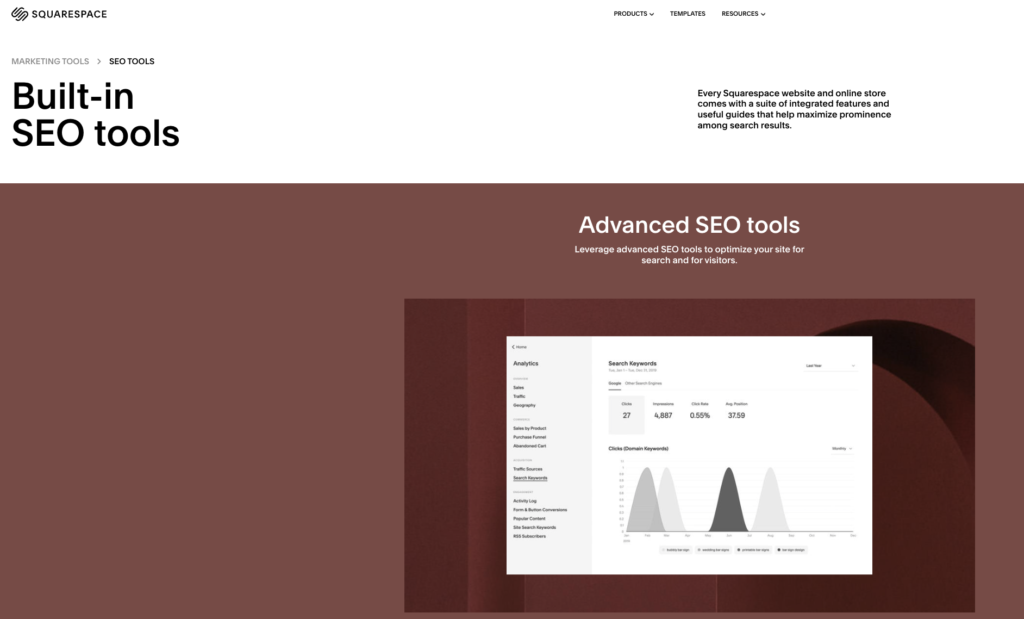In today’s day and age, every small business needs a website—it’s one of the first things that potential clients or customers will look for. Your website lets you list your contact information, highlight your expertise, and connect with customers. You can use it to grow an email list or text list. You can use it to sell products.
But we get it, building a website can seem pretty daunting, even if you’re fairly technically savvy. Luckily, there are tons of solutions that make building a website a breeze.
One of the most popular website builders for small businesses is Squarespace. In this article, we’ll go over the basics of building a great Squarespace website.
Benefits of Squarespace Websites for Small Business
With all the options to build small business websites, why do so many companies choose Squarespace? The following are just some of the benefits of this website builder.
Numerous Templates
To start, Squarespace makes it easy to create a website that looks professional by offering a wide range of templates. The variety allows you to choose a template that fits the image of your business without any web design experience.
Ease of Use
While there are other programs that make it easy to build a small business website, Squarespace is one of the easiest-to-use options. Even compared to other well-known, easy-to-use options like WordPress, many people prefer the simplicity of Squarespace.
Robust Options
In addition to the various templates they offer, Squarespace has plenty of options for the types of pages you’ll build. You can make an eCommerce site, blogs, portfolios, and more. This kind of flexibility is a key feature of the best website builders.
All-in-One
In addition to the various types of pages you can create, Squarespace handles everything. This includes SEO tools, analytics, hosting, domain, features, security, and templates. And that security is nothing to scoff at—Squarespace’s closed system makes it more secure.

Excellent Site Performance
Part of the reason Squarespace is considered one of the best website builders is its excellent site performance. That site performance ensures that your site visitors have a good experience and boosts your SEO.
Great Customer Support
Squarespace comes with 24/7 customer support, and most small businesses using the website builder agree that the support is helpful and prompt. You can frequently resolve your issues yourself through the Help Center’s resources. That is especially helpful in a small business website builder.
Various Pricing Plans
While Squarespace isn’t free, it is affordable, especially given what you get. This is helped by the fact that small businesses can choose from several different tiers or plans, allowing you to build a small business site that fits your budget.
Caveats to Remember
Keep in mind that while Squarespace is great, it is far from the only option to build your small business website. You should keep the following caveats in mind when choosing this platform:
- There is no free version
- It’s not ideal for multilingual websites
- It may not be ideal for an eCommerce site
- You get less design freedom
- You get less freedom of functionality than a WordPress website
How to Set Up a Squarespace Website
The process of setting up a Squarespace small business website is incredibly straightforward. As we’ve already mentioned, one of the major benefits of this small business website creator is its ease of use.
1 – Choose a Template
Start by choosing one of the templates from the Squarespace library.
2 – Get Your Domain Name
If you don’t already have one, the next step is to get your domain name. Consider using your brand name or relevant keywords.
3 – Add Pages One by One
Next, it’s time to add content. Start with the home page. You can also add a blog, an FAQ page, and other types of content.
But how do you actually go about adding the pages? Follow these steps:
- Head to “Pages” on the Home menu.
- Look at “Main Navigation” and click the “+” next to it.
- Choose your type of page. Alternatively, choose “Page Layouts” and select a pre-built layout.
- Type in a page title and select “Enter.”
- (Optional) Set it as a homepage.
- Add content using blocks (drag-and-drop builder for buttons, images, text, and more) or collection items (sets of content, such as events, products, or blog posts).
4 – Advertise Your Website
Once your new small business website is up and running, advertise it and start driving traffic. Brag about it on social media, add it to your receipts, and mention it in any in-store advertising.

Tips for Building the Best Small Business Squarespace Website
Now that you know the basics of building small business websites on Squarespace, let’s go over some tips for creating an amazing website. You’ll notice that most of these tips would apply to any type of website you make for your business, whether you hire a web designer or create the web pages yourself in just a few clicks.
Tip 1: Know Your Audience and Target Them
One of the most important things to keep in mind as you create any website is your target audience. You need to know your demographic and their various preferences. This will help you choose the appropriate layout, images, tone, and more.
Tip 2: Get Clear on Your Goals
You also need to make sure you know your goals—what are you trying to achieve with your website? This will influence your decisions. Your goals might include:
- Generating leads: If you want to generate leads using the website, it needs to have clear CTAs.
- Generating traffic: If you want to maximize traffic, share links to your social media pages on your website. And make it easy to sign up for the email list.
- Producing sales: If your goal is to sell your product online, make your products easy to find with clear prices and intuitive “Add to cart” buttons.
No matter your goal(s), there should be various calls to action on your website. After all, you don’t just want people to visit it and then leave. You want their visit to your website to be the first step they take toward becoming a loyal customer.
Tip 3: Keep Branding in Mind
As you design your website, keep your branding in mind. Include your logo or color scheme on the website. If your business is still in the early stages, you may not have those things yet. That’s not a problem—find an appealing image that represents your company in the meantime.
Here’s a little branding tip for you: As you choose your colors, make sure not to go overboard. Instead, focus on just a few colors that fit your brand.
Tip 4: Keep the Copy Clear and Concise
Your website visitors don’t want to read large chunks of text or have to think too hard about technical jargon. Break up text into digestible chunks with bullet points and headings, and make sure your copy is simple and straightforward.
Another pro tip: Take clarity to the next level by opting for an easy-to-read font.
Tip 5: Opt for Hero Images
When it comes to choosing the images for your website, opt for “hero” images. This means images that feature your audience’s “heroes” or people they want to become. A classic example is a gym’s website showing people who are in good shape.
Tip 6: Add Social Proof
Social proof is an excellent way to build trust in your local business, so add it to your website. This could be testimonials, reviews, or even posts on Instagram that tagged your company.
Tip 7: Don’t Be Afraid of Space
As you add text and images, don’t be afraid of empty space. Cramming too much onto your website can make it look busy and hurt its effect.
Start Building a Stellar Online Reputation
Creating the best small business website is just one part of the equation. From there, you need to harness the power of tools to improve the customer experience and build an online presence that potential customers can’t ignore.
Ready to build a better online reputation? Check out How to Get a 5-Star Rating on Google.




